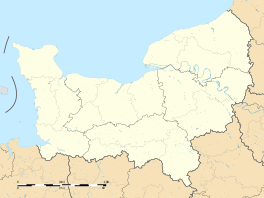Hiemois
| Exmes | |
|---|---|
| Coordinates: 48°45′40″N 0°10′50″E / 48.7611°N 0.1806°ECoordinates: 48°45′40″N 0°10′50″E / 48.7611°N 0.1806°E | |
| Country | France |
| Region | Normandy |
| Department | Orne |
| Arrondissement | Argentan |
| Canton | Argentan-2 |
| Area1 | 10.43 km2 (4.03 sq mi) |
| Population (2012)2 | 309 |
| • Density | 30/km2 (77/sq mi) |
| Demonym(s) | Hiémois |
| Time zone | CET (UTC+1) |
| • Summer (DST) | CEST (UTC+2) |
| INSEE/Postal code | 61157 /61310 |
| Elevation | 145–268 m (476–879 ft) (avg. 317 m or 1,040 ft) |
|
1 French Land Register data, which excludes lakes, ponds, glaciers > 1 km² (0.386 sq mi or 247 acres) and river estuaries. 2Population without double counting: residents of multiple communes (e.g., students and military personnel) only counted once. |
|
1 French Land Register data, which excludes lakes, ponds, glaciers > 1 km² (0.386 sq mi or 247 acres) and river estuaries.
Exmes [ɛm] is a former commune in the Orne department in north-western France. On 1 January 2017, it was merged into the new commune Gouffern en Auge. It was the seat of the county of Hiémois (French: ), granted before his death in 1027 by Richard II, Duke of Normandy to his younger son, Robert, who eventually succeeded as duke of Normandy. In 1136, Gilbert de Clare, Earl of Pembroke led an expedition against Exmes and burned parts of the town, including the church of Notre Dame.
Herbert de Losinga, Bishop of Norwich (c. 1095–1119) was born in Exmes as well as François Le Prévost d'Exmes (1729–1793), 18th-century playwright.
According to other sources, Exmes was the place of origin (after 1066 and the Battle of Hastings) of persons named (or later named) Amis, which name was later corrupted to various forms, including Amos. The name Amos is quite prevalent in the county of Kent (United Kingdom) around the Canterbury region.
...
Wikipedia


